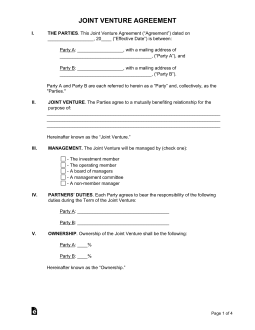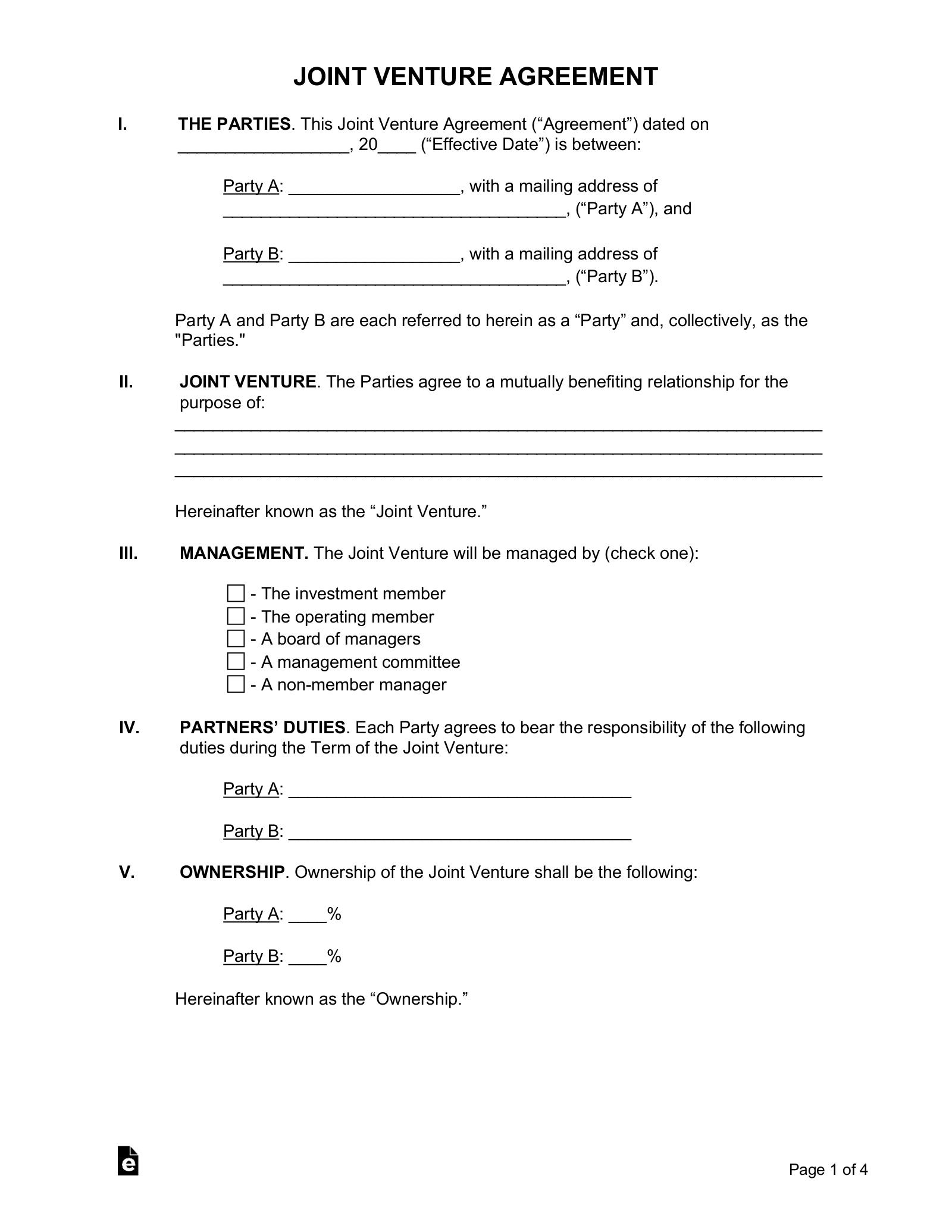Updated August 21, 2023
A joint venture agreement is a legal contract that unites two or more parties, whether individuals or companies, in the pursuit of a common goal. The contract stipulates that the parties will combine their resources in order to achieve mutually beneficial ends.
Common Uses
- Real estate developments;
- Capital investments;
- Construction projects;
- International partnerships; and
- Mergers and acquisitions.
Table of Contents |
Reasons to Form a Joint Venture
Often, the reason two parties decide to enter into a joint venture is to complete a specific project. Two companies might, for example, acknowledge that individually they lack the resources to access a particular technology that would enable a business venture to succeed. By joining together, they could share the burden of startup costs, gain access to the technology, then share in any profits generated as a result.
Sometimes, the reason for forming a joint venture is more related to strategy than capital. An alliance could, for example, enable two companies that specialize in two different fields to access or dominate a new market.
Another reason two companies might form a joint venture is to increase their likelihood of winning a tender or bid for a contract.
Benefits of a Joint Venture
The central question to ask before forming a joint venture is this: will sharing capacity and/or resources help us to achieve something we couldn’t achieve individually and separately? Will this arrangement be mutually beneficial? Consider the possibility of such benefits as:
- Increased access to resources
- Sharing of risk and startup costs, including marketing and operating costs
- Increased efficiency
- Ease of access to economies of scale
- Increased competitive advantage
- Expanded customer reach
Joint Venture vs. Limited-Liability Partnership
While a joint venture appears similar to a partnership, the two legal entities are in fact distinct and separate. The main difference relates to breadth; whereas a joint venture is generally contracted in order to enable two separate entities to jointly achieve a specific, fixed-term goal, a limited-liability partnership allows parties to jointly own and operate a company until such time as the company is dissolved.
| Joint Venture | Limited-Liability Partnership | |
| Main Purpose | Joint pursuit of a business goal or project | Agreement between company owners united by a broad purpose |
| Entity Required? | No | Yes |
| Time Period | Short-term | Long-term |
| Decision-making | Both parties | General partner only |
| Tax Liability | Flows to the company based on ownership percentage | Pass-through to individual |
Famous Examples (3)
Mercedes-Benz + Airstream

Since 2004, both companies have built RVs together. Mercedes-Benz provides the chassis and engineering while Airstream constructs the rest of the vehicle.
McDonald’s + Coca-Cola

Since 1955, Coca-Cola has provided soft drinks to McDonald’s to accompany their meals. Coca-Cola provided signage and other incentives as part of this venture.
American Airlines + Qantas

Since 2019, American Airlines and Qantas allows travelers to book trips using each other’s networks. This means a traveler looking to book a trip from Sydney to New York can do so on either airline’s website.
Previously, a traveler would have to book Qantas to get to the United States and then another airline to get to their final destination. The joint venture expands each airline’s customer base.
How to Form a Joint Venture (4 Steps)
2. Discuss Benefits

After identifying a candidate, it’s time for both parties to discuss how each might benefit from a joint venture agreement.
3. Establish an Agreement

A joint venture agreement should reflect strategic thinking in six areas:
- Contribution – What contributions of money, property, effort, knowledge, skill, or other assets will each party contribute?
- Joint interest – What is/are the parties’ joint interest(s)?
- Mutual control – Will the parties mutually control or manage the enterprise?
- Profit – Is there an expectation of profits?
- Profit rights – How will the parties share in any profits generated?
- Single objective – Is the objective limited to a specific timeframe or activity?
Terminating a Joint Venture
A joint venture agreement might allow for termination once the common goal has been achieved, once a certain date has been reached, or once the parties agree jointly to terminate.
Options for termination include:
- Consensus
- A court-ordered winding-up
- Sale of interests
A joint venture agreement should spell out what happens in the event one party or both parties wish to terminate the venture. Most agreements allow for termination with 30 days’ notice. The agreement should also outline what happens in the event of a breach, insolvency of one party, or an irreconcilable dispute.
Key Features of a Joint Venture Agreement
A joint venture agreement should include the names and contact information of all parties involved, the purpose of the venture, the roles and responsibilities of each party, the duration of the agreement, and the terms of the agreement. The agreement should also outline the venture’s ownership and management structure, the rights and obligations of each party, and the dispute resolution process.
A joint venture agreement should, in addition, contain provisions for the protection of intellectual property, confidentiality, and non-compete clauses, as well as provisions for the distribution of profits and losses, the taxation of the venture, and the indemnification of the parties.
Should an Agreement Address Confidentiality?
A confidentiality or non-disclosure agreement is a means of making sure that anyone who becomes privy to trade secrets or commercially sensitive information by virtue of being part of a joint venture won’t share or sell it to competitors when the agreement ends. This is important to include because while the joint venture will expire, the capacity to benefit from commercially valuable information won’t.
Sample
JOINT VENTURE AGREEMENT
THE PARTIES. This Joint Venture Agreement (“Agreement”) dated on [DATE] (“Effective Date”) is between:
Party A: [NAME OF PARTY A], with a mailing address of [MAILING ADDRESS OF PARTY A] (“Party A”), and
Party B: [NAME OF PARTY B], with a mailing address of [MAILING ADDRESS OF PARTY A] (“Party B”).
Party A and Party B are each referred to herein as a “Party” and, collectively, as the “Parties.”
JOINT VENTURE. The Parties agree to a mutually benefiting relationship for the purpose of:
[DESCRIPTION OF JOINT VENTURE]
Hereinafter known as the “Joint Venture.”
PARTNERS’ DUTIES. Each Party agrees to bear the responsibility of the following duties during the Term of the Joint Venture:
Party A: [RESPONSIBILITIES OF PARTY A]
Party B: [RESPONSIBILITIES OF PARTY B]
OWNERSHIP. Ownership of the Joint Venture shall be the following:
Party A: [#]%
Party B: [#]%
Hereinafter known as the “Ownership.”
PROFIT DISTRIBUTION. Profits of the Joint Venture shall be distributed: (check one)
☐ – In accordance with Ownership.
☐ – In accordance with the following:
Party A: [#]%
Party B: [#]%
Profits shall be defined as gross revenues less expenses and other contractual liabilities.
NON-COMPETE. Each Party shall be: (check one)
☐ – RESTRICTED from participating in similar business activities as the Joint Venture.
☐ – NOT RESTRICTED to withhold from participating in similar business activities as the Joint Venture.
CONTRIBUTIONS. Each Party agrees to contribute the following for the success of the Joint Venture:
Party A: (check applicable)
☐ – Cash: [$]
☐ – Other: [OTHER]
Party B: (check applicable)
☐ – Cash: [$]
☐ – Other: [OTHER]
Hereinafter known as the “Contributions.”
TERMINATION. This Agreement shall terminate in any of the following: (check applicable)
☐ – On the end date of [DATE].
☐ – At any time with [#] days’ notice.
☐ – Other: [OTHER]
Hereinafter known as the “Term.”
DISPUTES. The Partners agree to resolve any dispute arising out of this Agreement through polite interactions and negotiations. If any dispute cannot be resolved by negotiation within ninety (90) days, the Partners involved shall enter mediation in accordance with the rules under Governing Law.
If said mediation is not successful in resolving the dispute or is not applicable, any outstanding issues will be submitted to final and binding arbitration under the rules of the American Arbitration Association. The arbitrator’s award shall be final, and judgment may be entered upon it by any court having proper jurisdiction within the Governing Law.
ACKNOWLEDGMENTS. Each Party makes the following acknowledgments in this Agreement:
Mutually Benefiting. The Agreement does not constitute nor should be recognized as a partnership agreement, but as mutually benefiting terms for the purpose of the Joint Venture.
Confidentiality. Beginning on the Effective Date, both Parties shall be obligated to withhold sharing any proprietary information of each Party or of any details related to the Joint Venture (“Confidential Information”). Such Confidential Information shall include, but not be limited to, documents, plans, data, reports, concepts, strategies, finances, specifications, customer lists, pricing, sales, charts, profiles, goals, and any other related business activity.
IN WITNESS WHEREOF, this Agreement has been executed and delivered in the manner prescribed by law as of the Effective Date first written above.
Party A Signature: ________________________
Party B Signature: ________________________




